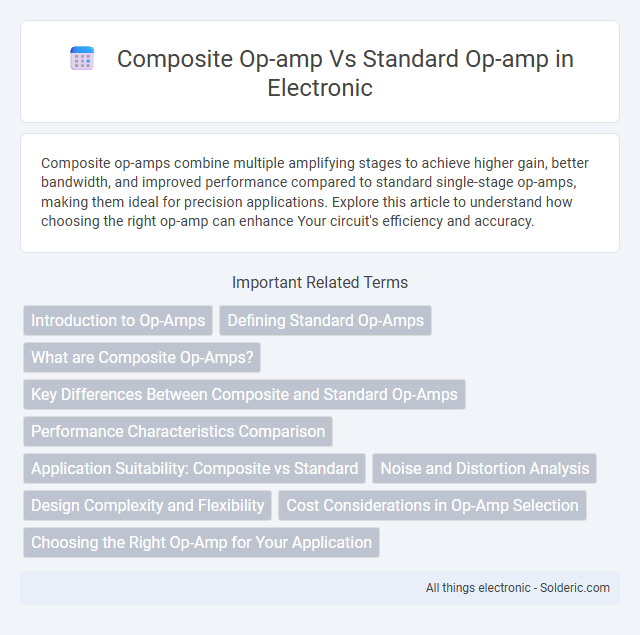Composite op-amps combine multiple amplifying stages to achieve higher gain, better bandwidth, and improved performance compared to standard single-stage op-amps, making them ideal for precision applications. Explore this article to understand how choosing the right op-amp can enhance Your circuit's efficiency and accuracy.
Comparison Table
| Feature | Composite Op-Amp | Standard Op-Amp |
|---|---|---|
| Structure | Two or more op-amps combined in a single configuration | Single op-amp unit |
| Gain | Higher gain due to cascaded stages | Standard gain limited by single stage |
| Bandwidth | Improved bandwidth with optimized stage arrangement | Typical bandwidth limited by internal design |
| Noise | Reduced input noise through specialized input stage | Higher noise relative to composite designs |
| Application | High-precision, low-noise, and high-gain amplification | General purpose amplification |
| Complexity | More complex circuit design and layout | Simpler, easier integration |
| Cost | Generally higher due to multiple op-amps | Lower cost, readily available |
Introduction to Op-Amps
Composite op-amps combine multiple operational amplifier stages to enhance overall performance metrics such as gain-bandwidth product, slew rate, and harmonic distortion, outperforming standard single-unit op-amps. Standard op-amps typically contain a single integrated amplifier stage designed for general-purpose applications, whereas composite op-amps leverage the strengths of each stage for precision and high-frequency applications. This structural difference makes composite op-amps ideal for demanding analog signal processing tasks requiring superior linearity and speed.
Defining Standard Op-Amps
Standard op-amps, or operational amplifiers, are integrated circuits designed for general-purpose amplification, featuring high gain, differential inputs, and a single-ended output. They typically operate with limited bandwidth and slew rate, making them suitable for basic analog signal processing tasks like filtering, amplification, and integration. Understanding standard op-amps allows you to evaluate their performance constraints compared to composite op-amps, which enhance bandwidth and stability by combining multiple amplification stages.
What are Composite Op-Amps?
Composite op-amps are advanced amplifier configurations combining multiple operational amplifiers to enhance overall performance, such as gain bandwidth, slew rate, and stability. These op-amps leverage the strengths of each stage, typically consisting of a low-noise input stage followed by high-speed gain stages, to achieve superior frequency response compared to standard op-amps. Understanding composite op-amps allows you to design circuits requiring precision and high-speed amplification beyond the capabilities of traditional single-stage operational amplifiers.
Key Differences Between Composite and Standard Op-Amps
Composite op-amps combine multiple operational amplifiers to achieve higher gain, wider bandwidth, and improved slew rate compared to standard op-amps, which typically consist of a single amplifier stage. Your choice between composite and standard op-amps depends on the application's requirements for performance metrics such as noise reduction, linearity, and frequency response. Composite op-amps offer superior accuracy and speed, making them ideal for precision instrumentation, while standard op-amps provide simpler design and lower cost for general-purpose uses.
Performance Characteristics Comparison
Composite op-amps offer superior gain-bandwidth product and improved slew rate compared to standard op-amps, enhancing high-frequency performance and stability. Their architecture reduces distortion and noise, making them ideal for precision applications requiring greater linearity and faster response times. Choosing a composite op-amp can significantly optimize Your circuit's dynamic range and transient response over conventional op-amps.
Application Suitability: Composite vs Standard
Composite op-amps offer superior performance in high-frequency and precision applications due to their enhanced gain-bandwidth product and improved slew rate compared to standard op-amps. Standard op-amps are suitable for general-purpose applications where moderate speed and accuracy meet design requirements without increased complexity. You should choose composite op-amps for demanding analog signal processing tasks, while standard op-amps remain cost-effective solutions for typical amplification needs.
Noise and Distortion Analysis
Composite op-amps exhibit lower noise levels and reduced distortion compared to standard op-amps due to their multi-stage design that optimizes gain and bandwidth separately. The noise performance improves as the first stage in a composite op-amp is designed for minimal input-referred noise, while subsequent stages handle higher gain with less impact on overall noise. Distortion is minimized because the architecture allows better linearization and feedback control, providing superior signal fidelity in precision applications.
Design Complexity and Flexibility
Composite op-amps offer greater design flexibility by combining multiple amplifier stages to tailor performance characteristics such as gain, bandwidth, and slew rate, which standard op-amps typically cannot match due to their fixed architecture. The increased design complexity of composite op-amps involves careful stage matching and compensation to ensure stability and reduced distortion, whereas standard op-amps provide simpler, ready-to-use solutions with limited customization. Your choice between these op-amps should balance the need for advanced performance tuning against the simplicity and reliability of standard op-amp designs.
Cost Considerations in Op-Amp Selection
Composite op-amps generally have higher initial costs compared to standard op-amps due to their complex internal architecture, which integrates multiple amplifier stages for enhanced performance. Standard op-amps are more cost-effective for simple applications with moderate performance requirements, offering a balance between price and functionality. When selecting an op-amp, budgeting constraints must consider not only unit price but also long-term benefits like improved gain-bandwidth product and distortion reduction provided by composite designs.
Choosing the Right Op-Amp for Your Application
Choosing the right op-amp for your application depends on factors like gain, bandwidth, and noise performance, where composite op-amps offer enhanced gain-bandwidth product and reduced distortion compared to standard op-amps. Composite op-amps combine multiple amplifiers to achieve higher performance, making them suitable for high-precision analog signal processing. Your application benefits from selecting composite op-amps when demanding accuracy and stability are critical, while standard op-amps remain ideal for general-purpose tasks with moderate requirements.
Composite op-amp vs Standard op-amp Infographic

 solderic.com
solderic.com